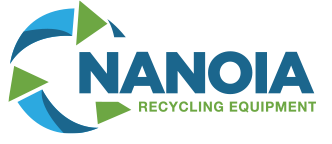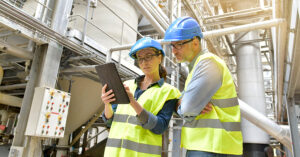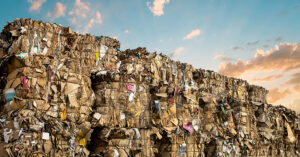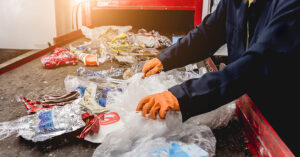Transporting and relocating industrial balers is no small task. We at Nanoia know this, as we undertake it often for our clients. You can see a couple of examples here and here.
These massive machines play a crucial role in recycling operations, and their safe and efficient movement is vital to maintaining business continuity.
Proper baler transportation and relocation involve a series of meticulously planned steps to ensure that the equipment is moved without damage and reinstalled correctly at its new location.
This article will delve into the detailed process of baler transportation and relocation, providing valuable insights even for those familiar with the topic.
Pre-Transportation Planning
Site Assessment
The first step in baler transportation is conducting a thorough site assessment. This involves evaluating both the current location and the new site where the baler will be installed.
Identifying potential obstacles such as narrow doorways, low ceilings, and tight corners is crucial to planning the move. This ensures that the route is clear and that any necessary adjustments can be made in advance to accommodate the baler’s dimensions.
Equipment Assessment
Understanding the specific type and model of the baler is essential. Different balers have unique requirements, and knowing these details helps in planning the transportation.
It’s also important to check the baler’s condition and note any special requirements, such as sensitive parts that may need extra protection or additional bracing during the move.
Documentation and Permits
Proper documentation is critical for legal and logistical reasons. Gather all necessary papers, including ownership documents and manuals.
Additionally, securing the appropriate permits for transportation is essential, particularly for oversized loads. These permits ensure that the transportation process complies with local and national regulations.
Preparing the Baler for Transport
Disconnection and Decommissioning
Safely disconnecting the baler from electrical and hydraulic systems is a critical step. Following proper decommissioning procedures prevents damage and ensures the equipment can be reconnected without issues at the new location.
This step often involves shutting down the baler in a controlled manner and systematically disconnecting it.
Securing and Stabilizing the Baler
To prevent any damage during transport, it’s important to secure moving parts and stabilize the baler. Using appropriate materials to lock down parts that could shift or become damaged in transit ensures the baler remains intact.
Stabilizing the baler also helps maintain balance during the move, reducing the risk of tipping or other accidents.
Transportation Methods
Choosing the Right Vehicle
Selecting the appropriate vehicle for transporting the baler depends on its size and weight. Options may include flatbed trucks, lowboy trailers, or other specialized transport vehicles designed to handle heavy loads.
It’s essential to choose a vehicle that can safely accommodate the baler’s dimensions and weight.
Loading the Baler
Loading the baler onto the transport vehicle requires careful planning and execution. Using cranes or forklifts with adequate capacity is essential.
Proper load distribution is crucial to maintain balance and ensure safe transportation. The loading process should be supervised by experienced personnel to avoid accidents.
Securing the Load
Once the baler is loaded, it must be securely fastened using heavy-duty straps and chains. All tie-down points should be checked to ensure they meet transport regulations.
Properly securing the load prevents shifting during transit, which could cause damage to the baler or the transport vehicle.
Relocation and Installation
Site Preparation
Preparing the new site to receive the baler involves several steps. The flooring may need reinforcement to support the baler’s weight, and access paths must be clear to allow for smooth installation.
Verifying that utilities such as electrical and hydraulic connections are ready is also crucial.
Unloading and Positioning
Unloading the baler at the new site should be done with the same care as the loading process. Cranes or forklifts are used to carefully lower the baler into place.
Accurate positioning according to the site plan is essential to ensure the baler operates correctly and integrates seamlessly into the existing workflow.
Reconnection and Commissioning
Reconnecting the baler to electrical and hydraulic systems must follow manufacturer guidelines to ensure proper functioning.
Once connected, commissioning tests are performed to verify that the baler operates correctly. This includes running the baler through its paces and making any necessary adjustments.
Common Challenges and Solutions
Navigating Tight Spaces
Moving a baler through tight spaces requires careful planning and specialized equipment. Compact, maneuverable machinery can help navigate narrow doorways and tight corners.
Planning alternative routes or making temporary modifications to the site can also facilitate the move.
Handling Heavy Loads
Balers are heavy, and handling these loads requires high-capacity lifting equipment. Ensuring that staff are trained in proper handling techniques reduces the risk of injuries and equipment damage. Using equipment rated for the baler’s weight ensures safe lifting and transport.
Dealing with Unforeseen Issues
Despite thorough planning, unforeseen issues can arise. Having contingency plans in place helps address delays or equipment failures quickly. Maintaining open communication with all stakeholders ensures that problems can be resolved efficiently, minimizing downtime.
Why Choose Nanoia Recycling Equipment?
Nanoia Recycling Equipment offers comprehensive solutions for baler transportation and relocation.
Our expert team handles everything from initial planning and preparation to final installation and commissioning. With years of experience and a commitment to excellence, we ensure that your baler move is seamless and stress-free.
For a custom solution tailored baler relocation project, contact us to learn how we can help.






